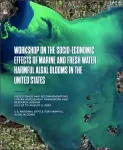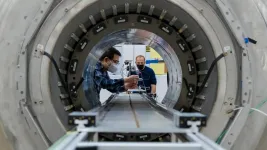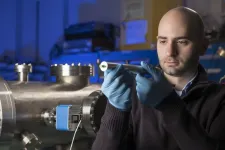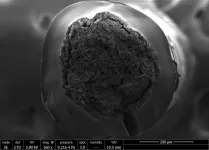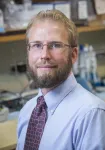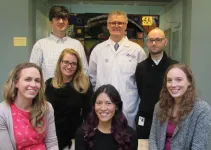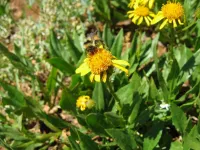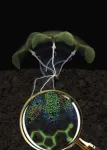INFORMATION:
About Woods Hole Oceanographic Institution
The Woods Hole Oceanographic Institution (WHOI) is a private, non-profit organization on Cape Cod, Massachusetts, dedicated to marine research, engineering, and higher education. Established in 1930, its primary mission is to understand the ocean and its interaction with the Earth as a whole, and to communicate an understanding of the ocean's role in the changing global environment. WHOI's pioneering discoveries stem from an ideal combination of science and engineering--one that has made it one of the most trusted and technically advanced leaders in basic and applied ocean research and exploration anywhere. WHOI is known for its multidisciplinary approach, superior ship operations, and unparalleled deep-sea robotics capabilities. We play a leading role in ocean observation and operate the most extensive suite of data-gathering platforms in the world. Top scientists, engineers, and students collaborate on more than 800 concurrent projects worldwide--both above and below the waves--pushing the boundaries of knowledge and possibility. For more information, please visit http://www.whoi.edu
WHOI and NOAA release report on U.S. socio-economic effects of harmful algal blooms
2021-04-07
(Press-News.org) Harmful algal blooms (HABs) occur in all 50 U.S. states and many produce toxins that cause illness or death in humans and commercially important species. However, attempts to place a more exact dollar value on the full range of these impacts often vary widely in their methods and level of detail, which hinders understanding of the scale of their socio-economic effects.
In order to improve and harmonize estimates of HABs impacts nationwide, the National Oceanic and Atmospheric Administration (NOAA) National Center for Coastal Ocean Science (NCCOS) and the U.S. National Office for Harmful Algal Blooms at the Woods Hole Oceanographic Institution (WHOI) convened a workshop led by WHOI Oceanographer Emeritus Porter Hoagland and NCCOS Monitoring and Event Response (MERHAB) Program Manager Marc Suddleson. Participants focused on approaches to better assess the socio-economic effects of harmful algal blooms in the marine and freshwater (primarily Great Lakes) ecosystems of the United States. The workshop proceedings report describes the group's objectives, and presents recommendations developed by 40 participants, mostly economists and social scientists from a range of universities, agencies, and U.S. regions. Their recommendations fall under two broad categories: those intended to help establish a socio-economic assessment framework, and those to help create a national agenda for HABs research.
"This has been a goal of the research and response communities for a long time, but coming up with a robust national estimate has been difficult, for a number of reasons, mainly related to the diversity of algal species and the wide variety of ways they can affect how humans use the oceans and freshwater bodies," said Hoagland. "This gives us a strong base on which to build the insight that will vastly improve our estimates."
Framework recommendations call for enhancing interagency coordination; improving research communications and coordination among research networks; integrating socioeconomic assessments into HAB forecasts and observing networks; using open-access databases to establish baselines and identify baseline departures; facilitating rapid response socio-economic studies; improving public health outcome reporting and visibility of HAB-related illnesses; fostering the use of local and traditional ecological knowledge to improve HAB responses; engaging affected communities in citizen science; and engaging graduate students in HAB socio-economic research.
Research agenda recommendations include elements necessary for addressing gaps in our understanding of the social and economic effects of HABs. They include a suggested approach for obtaining an improved national estimate of the economic effects of HABs; supporting rapid ethnographic assessments and in depth assessments of social impacts from HABs; defining socioeconomic impact thresholds for triggering more detailed studies of impacts (such as in the case of designated HAB events of significance); sponsoring research on the value of scientific research leading to improved understanding of bloom ecology; assessing the value of HAB mitigation efforts, such as forecasts, and control approaches and their respective implementation costs; and supporting research to improve HAB risk communication and tracking and to better understand the incidence, severity, and costs of HAB-related human illnesses.
"These recommendations give us a strong series of next steps to increase focus on HAB-related socio-economic research," said Don Anderson, director of the U.S. National Office for Harmful Algal Blooms. "The report is certain to spur increased collaborations that will provide a better understanding of the many complex socio-economic effects of HABs and provide the tools to increase the effectiveness of efforts to minimize impacts on society and the environment."
The detailed final proceedings report and more information about the workshop is available on the U.S. National HAB Office website.
ELSE PRESS RELEASES FROM THIS DATE:
Field guides: Argonne scientists bolster evidence of new physics in Muon g-2 experiment
2021-04-07
Scientists are testing our fundamental understanding of the universe, and there's much more to discover.
What do touch screens, radiation therapy and shrink wrap have in common? They were all made possible by particle physics research. Discoveries of how the universe works at the smallest scale often lead to huge advances in technology we use every day.
Scientists from the U.S. Department of Energy's (DOE) Argonne National Laboratory and Fermi National Accelerator Laboratory, along with collaborators from 46 other institutions and seven countries, are conducting an experiment to put our current understanding of the universe to the test. The first result points to the existence of undiscovered particles or forces. This new physics could help explain long-standing ...
First results from Fermilab's Muon g-2 experiment strengthen evidence of new physics
2021-04-07
AMHERST Mass. - The long-awaited first results from the Muon g-2 experiment at the U.S. Department of Energy's Fermi National Accelerator Laboratory show fundamental particles called muons behaving in a way that is not predicted by scientists' best theory, the Standard Model of particle physics. This landmark result, made with unprecedented precision and to which UMass Amherst's David Kawall's research group made key contributions, confirms a discrepancy that has been gnawing at researchers for decades.
"Today is an extraordinary day, long awaited ...
Surgical sutures inspired by human tendons
2021-04-07
Sutures are used to close wounds and speed up the natural healing process, but they can also complicate matters by causing damage to soft tissues with their stiff fibers. To remedy the problem, researchers from Montreal have developed innovative tough gel sheathed (TGS) sutures inspired by the human tendon.
These next-generation sutures contain a slippery, yet tough gel envelop, imitating the structure of soft connective tissues. In putting the TGS sutures to the test, the researchers found that the nearly frictionless gel surface mitigated the damage typically ...
Research brief: Reflecting sunlight could cool the Earth's ecosystem
2021-04-07
Published in the Proceedings of National Academy of Sciences, researchers in the Climate Intervention Biology Working Group -- including Jessica Hellmann from the University of Minnesota Institute on the Environment -- explored the effect of solar climate interventions on ecology.
Composed of climate scientists and ecologists from leading research universities internationally, the team found that more research is needed to understand the ecological impacts of solar radiation modification (SRM) technologies that reflect small amounts of sunlight back into space. The team focused on a specific proposed SRM strategy -- referred ...
Race and poverty appear to guide heart muscle DNA methylation in heart-failure patients
2021-04-07
BIRMINGHAM, Ala. - Race associates with the risk of death from end-stage heart failure. So, identifying the molecular determinants of that risk may help the pursuit of the novel diagnosis and prognosis of heart failure, and its therapy.
A University of Alabama at Birmingham study of end-stage heart-failure patients has found that cytosine-p-guanine, or CpG, methylation of the DNA in the heart has a bimodal distribution among the patients, and that race -- African American versus Caucasian -- was the sole variable in patient records that explained the difference. A subsequent ...
Parkinson's discovery points to possible future treatment approaches
2021-04-07
More than 20 years after the discovery of the parkin gene linked to young-onset Parkinson's disease, researchers at The Ottawa Hospital and the University of Ottawa may have finally figured out how this mysterious gene protects the brain.
Using human and mouse brain samples and engineered cells, they found that the parkin protein works in two ways. First, it acts like a powerful antioxidant that disarms potentially harmful oxidants in the brain, including dopamine radicals. Second, as the brain ages and dopamine radicals continue to build up, parkin sequesters these harmful molecules in a special storage site within vulnerable nerve cells, so they can continue to ...
Why our brains miss opportunities to improve through subtraction
2021-04-07
CHARLOTTESVILLE, Va. -- If, as the saying goes, less is more, why do we humans overdo so much?
In a new paper featured on the cover of Nature, University of Virginia researchers explain why people rarely look at a situation, object or idea that needs improving -- in all kinds of contexts -- and think to remove something as a solution. Instead, we almost always add some element, whether it helps or not.
The team's findings suggest a fundamental reason that people struggle with overwhelming schedules, that institutions bog down in proliferating red tape, and, of particular ...
Predicting COVID-19 outbreaks with cell phone mobility data
2021-04-07
Mobility tracking using cell phone data showing greater movement of people is a strong predictor of increased rates of COVID-19, according to new data in CMAJ (Canadian Medical Association Journal).
"This study shows that mobility strongly predicts [severe acute respiratory syndrome coronavirus 2] SARS-CoV-2 growth rate up to 3 weeks in the future, and that stringent measures will continue to be necessary through spring 2021 in Canada," writes Dr. Kevin Brown, Public Health Ontario, with coauthors.
Until Canadians are widely vaccinated against SARS-CoV-2, nonpharmaceutical public health interventions such as physical distancing and limiting social contact will be the main population-based means of controlling the spread of the virus.
"Mobility ...
Genome sequencing reveals a new species of bumblebee
2021-04-07
While studying genetic diversity in bumblebees in the Rocky Mountains, USA, researchers from Uppsala University discovered a new species. They named it Bombus incognitus and present their findings in the journal Molecular Biology and Evolution.
Bumblebees are vital for agriculture and the natural world due to their role in plant pollination. There are more than 250 species of bumblebee, and they are found mainly in northern temperate regions of the planet. Alarmingly, many species are declining due to the effects of climate change, and those with alpine and arctic habitats are particularly threatened. However, the full diversity of bumblebee ...
New biosensor makes control hormone auxin visible in cells
2021-04-07
The hormone auxin is of central importance for the development of plants. Scientists at the University of Bayreuth and the Max Planck Institute for Developmental Biology in Tübingen have now developed a novel sensor that makes the spatial distribution of auxin in the cells of living plants visible in real time. The sensor opens up completely new insights into the inner workings of plants for researchers. Moreover, the influences of changing environmental conditions on growth can now also be quickly detected. The team presents its research results in the journal Nature.
The effects of the plant hormone auxin were first described ...
